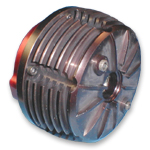| High Rpm Engagement Clutches
Racing Gokarts typically have the high performance high rpm engaging clutches.  Liquid Clutches Liquid clutches are durable and expensive. They are similar to the centrifugal clutch in that they operate on speed. They also typically are used with a one speed set up. The way a Liquid Clutch works is that it has two turbine wheels contained in a sealed oil container. The engine turbine wheel wheel spins and causes the oil to spray out at the second paddle wheel. The second paddle wheel, which is connected to the drive sprocket, takes the energy from the moving oil and starts to spin until up to the same speed as the engine turbine. Most gokart traks that run their gokarts all day use Liquid clutches. The oil inside the clutch absorbs the heat, and prevents damage to the clutch from occurring. Also, higher engine speeds, at idle can be achieved without any adverse effects. Electric Clutches Electric Clutches are simple and expensive. They also require a minimum of a constant 3 amp 12 volt electrical supply. A battery and a charging system would be required to operate such a system. The way an a electric clutch works is that a stationary electromagnetic is positioned under a cast iron movable driven member. The clutch driver is a flexible plate that hovers above the cast iron disk. When the magnet is actuated the iron disc becomes magnetized and draws the driver towards it. As the driver is drawn to the iron disk, they slip acting as a clutch. Heat is given off in the engagement event. The clutch engagement force is related to the magnetic force imparted by the electromagnetic. Typically, the magnetic clutches are used in air conditioning drivers for automobiles. The price typically ranges from $60-100. The mounting for the clutch would be primarily mounted on the axel shaft. Hydraulic System The hydraulic system is by far the most versatile, complicated, and expensive system to use ($400+). The system gives the design greater packaging options, however, speed and performance are not as great as those of the more direct methods. Hydraulic losses, in particular, are the detriment of this type of system. The losses come in hydraulic oil flow friction, pump and motor friction, and oil break down (heat). The system operates on the principle of building pressure. A pump is mounted on the engine, and hoses are routed to a hydraulic valve block. When the system is activated, or engaged, the hydraulic motor receives pressurized oil from the pump. Engines can be stalled in this system, if not adequately matched to the pumps and motors. The advantage of such a system is incorporating 4 wheel drive, or 4 wheel steer systems into the design. The elimination of chains, sprockets and belts is part of the advantage. It is not just as simple, however, as routing hoses, mounting a reservoir tank and some manifolds. Consulting a hydraulics house would be recommended prior to buying components. |
The GKG Mailing List
Great Birthday Present
Any Occasion Gift Idea


